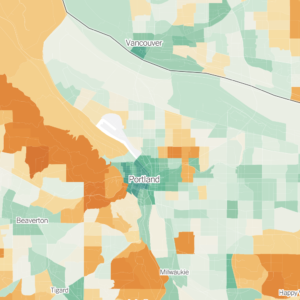For all the critiques lobbed at the Oregon Department of Transportation on this website, the fact is they actually do a lot of very good and important work. While the bad stuff (which is mostly how they throw billions at freeway expansions and don’t do enough to reduce driving capacity and improve safety on urban arterials) tends to overshadow where they’re actually moving forward, that doesn’t mean change and progress isn’t happening at the agency.
During an update on ODOT’s safety work shared at the May 9th Oregon Transportation Commission meeting, the agency’s Policy, Data and Analysis Division Administrator Amanda Pietz shared several important items. Chief among them is a map that just launched a few months ago that gives us a more up-to-date and interactive view of where people are dying on Oregon roads.
Beyond engineering, enforcement, education, data is a huge part any good road safety program. Similar to the City of Portland and Metro, ODOT wants zero deaths to occur on the entire system. They’ve stated a goal of “no deaths or life-changing injuries on Oregon’s transportation system by 2035.” And that’ll be an extremely tall order given current trends.

Fatality rates in Oregon are the highest they’ve been in three decades and we’ve settled into a grim average of about 600 deaths per year — about half of which occurred on state-owned roads. The number of people killed while walking is a “pressing issue” according to one slide shared at last week’s meeting. 126 pedestrians were killed in 2022 compared to the previous five year average of 80.
One shocking graph Pietz shared was how all types of crashes increased in 2022 versus the five year average from 2017 to 2021. Intersection crashes were up 71%. Crashes that happened around a school bus or in a school zone were up 109%! This chart is the best illustration of the post-pandemic driving freak-out I’ve ever seen.
Pietz is big on data and believes it’s key to reaching zero deaths. On that note, she shared ODOT’s Crash Analysis & Reporting Unit Initial Fatal Crash Information Viewer (CARUIFCIV, lol). It’s a GIS-based map that contains information on all fatal crashes in the state. So far the map includes details about all fatals from 2023 and 2024.
The timeliness of this information is a new thing for ODOT.
In the past, data would take months — even years — to trickle out of city police and DMV reports, then local transportation departments and eventually to State databases. But with “crash data timeliness” one of the areas ODOT was tasked to address in their Strategic Plan, Pietz and her team have rolled out this map as one way to tackle that problem.
“When we get a report about a death we enter it that night,” Pietz told Transportation Commission members at their May 9th meeting. “So this is essentially live information where you can see traffic fatalities across the state that’s interactive. So instead of waiting a year, or even longer in some cases, to have that information, we have it live so we can start to be more responsive to some of those things.”
If you’re an advocate, city staffer, or in the media, you’ll definitely want to bookmark this page. And hopefully by 2035, you can delete it.
— For more see ODOT’s Crash Data and Statistics page.








Thanks for reading.
BikePortland has served this community with independent community journalism since 2005. We rely on subscriptions from readers like you to survive. Your financial support is vital in keeping this valuable resource alive and well.
Please subscribe today to strengthen and expand our work.
Weird that they built this in ArcGIS Web App Viewer, which is deprecated and being retired in July. I expect they’ll have to rebuild it soon in ArcGIS Experience Builder, which is what many of us GIS types are having to do with other web map apps.